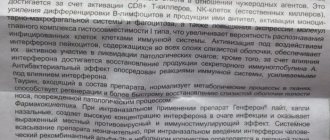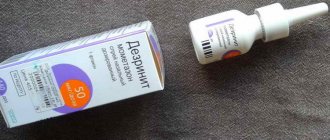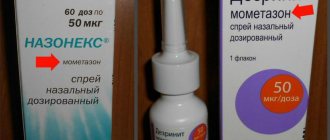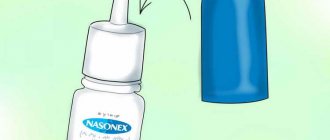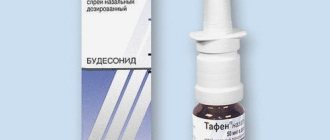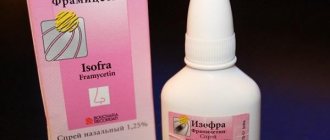Pharmacodynamics and pharmacokinetics
Miacalcic contains the active ingredient calcitonin , which is a hormone produced by C-cells located in the thyroid gland. This hormone is characterized by antagonism to parathyroid hormone and, in parallel with it, takes part in regulating calcium metabolism in the human body.
The structure of all calcitonins is one chain consisting of 32 amino acids , as well as a ring, including 7 amino acid residues located at the N-terminus, with different sequences depending on the species. Due to the higher affinity of salmon calcitonin for the corresponding receptors (compared to mammalian calcitonins ), the strength and duration of its action are more pronounced.
Due to the influence of salmon calcitonin osteoclast activity is inhibited , which leads to a significant decrease in the metabolic rate in bone tissue and, in painful conditions characterized by increased resorption (for example, osteoporosis ), brings it to a normal level. Also noted is the analgesic effect of Miacalcic in relation to pain syndrome of bone origin, which appears, apparently, due to the direct effect of the drug on the central nervous system.
Already with a single use of the medicinal product Miacalcic in the form of an injection solution or nasal spray, the patient experiences a biological, clinically significant response, manifested by an increase in the excretion of calcium , sodium and phosphorus (due to weakening of tubular reabsorption ) and a decrease in the excretion of hydroxyproline .
Long-term intranasal or parenteral administration of Miacalcic leads to a significant decrease in the content of biochemical markers inherent in bone metabolism, including pyridinoline , bone alkaline phosphatase isoenzymes and serum C-telopeptides .
Parenteral administration of calcitonin reduces exocrine and gastric pancreatic secretion , which determines the effectiveness of Miacalcic in the treatment of acute pancreatitis .
When using Miacalcic nasal spray, there is a statistically significant increase (1-2%) mineral density in the lumbar vertebrae, determined in the first year of therapy and maintained for 5 years. In the femur, Miacalcic helps maintain normal mineral density .
The use of Miacalcic spray in a daily dosage of 200 IU led to a clinically and statistically significant decrease (36%) in the risk of fresh vertebral fractures , which was noted in the group of patients receiving combinatorial treatment with Miacalcic, calcium and vitamin D , in comparison with the group of patients receiving calcium supplements , vitamin D and placebo . In addition, in patients of the first group, a decrease in the incidence of multiple fractures of the spinal vertebrae by 35%.
With subcutaneous and intramuscular administration, the bioavailability of salmon calcitonin is approximately 70%, with intranasal application (in the nasal cavities) - 3-5%, in relation to the parenterally administered drug. Plasma Cmax with intramuscular administration is achieved within 60 minutes, with subcutaneous injection within 23 minutes, with intranasal administration, on average, after 10 minutes.
The apparent VSS of the drug is 0.15-0.3 l/kg. Binding to plasma proteins occurs by 30-40%. Up to 95% of calcitonin and its metabolic products are excreted by the kidneys, while only 2% of the active ingredient is excreted in unchanged form. T1/2 with intramuscular injection takes approximately 60 minutes, with subcutaneous injection - 60-90 minutes, with intranasal administration - 20 minutes.
With repeated intranasal injections of the drug, the accumulation of its active ingredient does not occur. In the case of using doses of Miacalcic that exceed the recommended ones, its higher concentrations are found in the plasma (as confirmed by an increase in AUC), while the relative bioavailability of the drug does not increase. Penetration of the drug through the placental barrier is not observed.
Determination of the plasma content of salmon calcitonin , like other polypeptide hormones , is not an indicator of its effectiveness, which should be determined by clinical indicators of the productivity of the therapy.
pharmachologic effect
Salmon calcitonin is a calcitonin receptor agonist that acts primarily on bone, but direct renal and gastrointestinal effects are also recognized. Calcitonin, which is part of the Calcinase spray, has the ability to regulate calcium metabolism, help normalize osteoclast activity and increase osteoblastic activity, which reduces the release of calcium from bones. Affects the inhibition of osteolysis, reducing the amount of calcium in the blood.
Indications for use
Miacalcic injection solution and spray are indicated for use in:
- deforming osteodystrophy (Paget's disease);
- sensation of bone pain associated with osteopenia and/or osteolysis ;
- postmenopausal osteoporosis (at early and late stages of development);
- neurodystrophic pathologies (Sudek's atrophy, algoneurodystrophy) caused by various predisposing and etiological factors, including: painful post-traumatic osteoporosis , glenohumeral syndrome , reflex dystrophy, causalgic syndrome , neurotrophic drug disorders.
Additionally, the injection solution is used for:
- primary senile osteoporosis in men and women;
- secondary osteoporosis , including that developed due to prolonged immobilization and treatment with glucocorticoids ;
- acute pancreatitis (as a means of additional therapy);
- hypercalcemic crisis and hypercalcemia caused by the following painful conditions: osteolysis provoked by malignant tumors ( myeloma , carcinoma of the lungs, breast, kidneys); prolonged immobilization ; hyperparathyroidism ; intoxication (poisoning) with vitamin D ; (used for the relief of acute conditions and for long-term therapy of chronic pathologies, until the effect of specific treatment of the underlying disease manifests itself).
Side effects
When using the injection solution and spray Miacalcic, undesirable side effects may occur such as: dizziness , nausea/vomiting, arthralgia , mild flushing of the facial skin with a feeling of warmth. Dizziness, nausea / vomiting and hot flashes were dose-dependent and were more often observed with intravenous administration of Miacalcic, compared with its subcutaneous or intramuscular use. During therapy using Miacalcic, chills and polyuria , which, as a rule, disappear on their own and only sometimes require a temporary reduction in the dosage of the drug.
Also, with varying frequency of manifestations, the use of Miacalcic can lead to the following negative phenomena.
Often:
- headache;
- arthralgia;
- dizziness;
- stomach ache;
- taste disorders;
- tides;
- nausea;
- increased fatigue ;
- diarrhea.
Sometimes:
- visual disturbances;
- arterial hypertension;
- swelling of the face;
- vomit;
- pain in muscles and bones;
- influenza-like syndrome;
- generalized and peripheral edema.
Rarely:
- hypersensitivity;
- polyuria;
- generalized rash;
- chills;
- itching;
- reactions at the injection site.
Rarely:
- anaphylactic shock;
- other anaphylactoid and anaphylactic reactions.
Additionally, the following side effects were observed when using Miacalcic spray.
Often:
- rhinitis;
- irritation;
- soreness in the nasal cavities;
- mucosal erythema;
- congestion;
- unpleasant odor;
- swelling of the mucous membrane;
- allergic rhinitis;
- sneezing;
- dryness in the nasal cavity;
- formation of excoriations in the nasal cavities.
Often:
- pharyngitis;
- nosebleeds;
- ulcerative rhinitis;
- sinusitis.
Sometimes:
- cough.
Instructions for use of Miacalcic (Method and dosage)
Miacalcic injection solution, instructions for use
Miacalcic in the form of an injection solution is intended for subcutaneous, intramuscular and intravenous administration.
For the treatment of osteoporosis, subcutaneous or intramuscular administration of the drug is indicated in a daily dosage of 50 IU or 100 IU every day or every 24 hours (depending on the severity of the disease). To prevent the progression of bone loss, it is recommended to prescribe vitamin D and calcium in adequate doses in parallel with Miacalcic.
For painful bone syndrome associated with osteopenia and/or osteolysis , daily administrations are prescribed in a daily dose of 100-200 IU. The drug can be administered by infusion (in saline solution), as well as by intramuscular or subcutaneous injections in a series of injections until satisfactory clinical efficacy is achieved. The dosage of Miacalcic should be adjusted taking into account the patient's response to therapy.
It may take several days analgesic effect to develop If long-term treatment is necessary, the initial daily dosage of the drug and/or the frequency of its use is usually reduced.
For Paget's disease, Miacalcic is administered intramuscularly and/or subcutaneously at a daily dosage of 100 IU, applied daily or every 24 hours. The minimum duration of therapy is 3 months. The dose of the drug is selected taking into account the patient's response to the treatment.
Emergency treatment of a hypercalcemic crisis is carried out in the form of infusion, which is most effective in relieving emergency and other severe painful conditions. In this case, the daily dose of Miacalcic is calculated per kilogram of the patient’s weight and is usually 5-10 IU/kg, dissolved in 500 ml of saline solution . The infusion is carried out over a minimum of 6 hours. Slow intravenous administration of Miacalcic is also allowed, dividing the daily dosage of the drug into 2-4 times.
Long-term treatment hypercalcemia is recommended to be carried out in the form of intramuscular or subcutaneous injections in a daily dosage of 5-10 IU/kg, used once or twice every 24 hours. The dosage regimen is adjusted based on the clinical dynamics of the patient’s condition and his biochemical parameters . If the required Miacalcic dose volume of 2 ml is exceeded, preference is given to intramuscular injections carried out in different places.
In the treatment of neurodystrophic pathologies, early diagnosis of the disease is extremely important. Treatment begins immediately after an accurate diagnosis. Miacalcic is prescribed in the form of intramuscular and/or subcutaneous injections in a daily dosage of 100 IU, administered over 2-4 weeks. Continuation of treatment is possible with the administration of the drug at 100 IU every 24 hours for up to 6 weeks (consistent with the dynamics of the patient’s painful condition).
Treatment of acute pancreatitis with the use of Miacalcic is carried out as part of a combinatorial conservative treatment. The drug is administered as an infusion at a dose of 300 IU dissolved in saline . Infusions are carried out over 24 hours for 6 days in a row.
Miacalcic spray, instructions for use
Miacalcic spray is intended for intranasal use (in the nasal cavity). It is recommended to administer the spray by alternating the nasal passages.
For the treatment of osteoporosis , a daily dose of Miacalcic is prescribed, amounting to 200 IU. To prevent the progression of bone loss, it is recommended to prescribe vitamin D and calcium in adequate doses in parallel with the spray. Treatment is carried out over a long period of time.
For painful bone syndrome associated with osteopenia and/or osteolysis , a spray is used in a daily dosage of 200-400 IU, administered daily. A dose of 200 IU can be used simultaneously. Higher dosages must be administered in several doses. The dose of Miacalcic spray should be adjusted according to the individual needs of the patient.
It may take several days analgesic effect to develop If long-term treatment is necessary, the initial daily dosage of the drug and/or the frequency of its use is usually reduced.
For Paget's disease, daily use of the spray is recommended at a daily dosage of 200 IU. Sometimes, at the beginning of therapy, a daily dose of 400 IU, administered in several doses, may be necessary. The minimum duration of treatment should be 3 months. The dosage is adjusted taking into account the personal needs of the patient.
Treatment with Miacalc for Paget's disease should be continued continuously for several months or even several years. When carrying out such therapy, a significant decrease in plasma alkaline phosphatase and renal excretion of hydroxyproline , sometimes to standard values. However, in some cases, an increase in these indicators was noted after their initial decrease. If such a clinical picture is detected, the doctor should consider the advisability of discontinuing treatment and its subsequent resumption.
Several months after completion of therapy, disorders of bone and tissue metabolism may occur again. In this case, a repeat course of treatment is required.
In the treatment of neurodystrophic pathologies, early diagnosis of the disease is extremely important. Treatment begins immediately after an accurate diagnosis. Miacalcic is prescribed in the form of a spray in a daily dose of 200 IU once daily for 2-4 weeks. Continuation of treatment is possible with the administration of the drug 200 IU every 24 hours for up to 6 weeks (consistent with the dynamics of the patient’s painful condition).
Experience with the use of Miacalcic injection solution and spray in pediatrics is quite limited, and therefore it is not possible to give recommendations for their use in this age group.
Significant experience with the use of both dosage forms of Miacalcic, used for the treatment of elderly patients, confirms the normal tolerability of the drugs by patients in this age group, as well as the absence of the need to adjust the dosage regimen. The same picture is observed in patients with / kidney pathologies , although targeted studies of the effect of Miacalcic on patients in these groups have not been conducted.
Device for administering nasal spray
The primary packaging of the spray used for further intranasal use is:
- a bottle containing a solution of the drug in a volume sufficient for at least 14 injections;
- a protective cap that protects the tip from contamination and the outlet from clogging;
- a tip intended for insertion into the nasal passage;
- a sprayer (piston), which is a moving part of the bottle used for the procedure of spraying the solution;
- the outlet is a small hole in the center of the tip through which the solution is injected;
- the tube is located inside the bottle and serves to supply the solution after pressing the sprayer;
- a dose counter showing the doses used; a window on the sprayer (on a full bottle the window is completely red).
Preparing the nasal spray for use
Shaking the bottle with the drug is not allowed, as this may cause the formation of air bubbles in the solution, which will lead to incorrect dosing of the drug.
The dosage counter window for unused spray should be red.
When using the spray for the first time, remove the protective cap from the tip of the sprayer and, holding the bottle vertically, make three preliminary presses on the piston to remove air from the tube. This procedure is carried out once to bring the spray into working condition. When removing air from the tube, slight splashing of the solution itself is allowed, which is provided by the manufacturer and does not affect the further number of doses.
You should pay attention to the color change in the counter window after each subsequent press on the piston. After the third preventive press, a green color should appear in the window, indicating that the device is ready for further use.
Method of using nasal spray
- To properly use Miacalcic nasal spray, the patient should tilt his head slightly forward and insert the tip of the spray into the nasal passage. Make sure that the tip of the nebulizer is positioned in line with the nasal passage to ensure even distribution of the drug.
- Press the piston once.
- Remove the tip from the nasal passage and take several active breaths through the nose to prevent the solution from leaking out.
- You should not clear your nasal passage immediately after using the drug.
- If the doctor prescribes 2 injections at a time, the second procedure is carried out in the other nasal passage.
- After using the spray, carefully wipe the spray tip with a dry, clean cloth and put the protective cap on it.
Nasal spray dose recording
Before using the spray, as well as after its use, it is necessary to mark the number in the dosage counter window, which should increase by one value after each subsequent injection of one dose of the drug. A bottle of nasal spray includes 14 full doses, but taking into account the supply of solution provided by the manufacturer, it is possible to carry out 2 additional sprays.
The appearance of the number 16 in the dose window means the complete absence of solution in the bottle. A slight residue of the drug at the bottom of the bottle cannot be used.
Additional warnings
Do not disassemble the spray device or attempt to enlarge the tip opening using a needle or other sharp object. Such interference will lead to serious disruption of the operation of the spraying device. If you have any doubts about the correct operation of the device, you should consult with a specialist at the pharmacy where the spray was purchased.
To ensure accurate dosage measurements, the vial of the drug should be stored and transported in an upright position. Shaking the bottle is not allowed. Sudden temperature changes should be avoided. The used bottle can be stored at room temperature for a maximum of 4 weeks.
Storage conditions
Before use, the drug should be stored in a dry place, out of reach of children, at a temperature of 2-8 °C. However, it is not allowed to freeze “Miakaltsik”. It is strictly forbidden to store ampoules open (since they contain no preservatives). After starting use, the spray retains its healing properties for up to 4 weeks, but only if it is stored in a dark place (not a refrigerator) at a temperature of up to 25 ° C, constantly in an upright position.
Shelf life of the drug in unopened form:
- For Miacalcic ampoules – 5 years;
- For spray – 3 years.
Overdose
Negative symptoms of overdose with parenteral administration of Miacalcic are manifested by hot flashes , nausea/vomiting and dizziness , which are dose-dependent. When using Miacalcic intranasally in the form of a spray, similar phenomena can be expected. However, there are reports of cases of using Miacalcic spray in single doses of up to 1600 IU and in daily doses of 800 IU, used for 3 days, which did not lead to any serious negative effects. Cases of overdose with Miacalcic spray are occasional. An overdose of salmon calcitonin may cause hypocalcemia , accompanied by muscle twitching and paresthesia .
salmon calcitonin overdose should be appropriate to the negative symptoms observed. In case of development of hypocalcemia, of calcium gluconate is indicated .
Drug interactions
A full-scale study of the consequences of using calcitonin with other drugs has not been conducted. However, in the course of basic clinical studies, it was found that the combined use of Miacalcic and lithium-containing drugs leads to a noticeable decrease in lithium in the blood plasma. Therefore, if you have to combine these medications, be sure to ask your doctor to adjust the dosage of the medications.
Overdose of "Miacalcic"
The drug goes on sale in special ampoules and bottles, so the possibility of an overdose when using it is negligible. However, it will not be superfluous to have this information at hand. So:
- Symptoms of overdose include nausea and vomiting, general weakness and dizziness, parasthesia and muscle twitching;
- During treatment, they resort to symptomatic therapy, as well as the administration of calcium gluconate (the latter only by qualified medical personnel).
special instructions
A physician or nurse experienced in performing subcutaneous injections should instruct the patient in the proper technique for performing such procedures independently.
Miacalcic injection solution contains less than 23 mg sodium .
Before injecting Miacalcic, it is necessary to visually examine the condition of the solution and ampoule of the drug. It is allowed to use a colorless, transparent injection solution that does not contain foreign inclusions, enclosed in an intact ampoule. After a one-time use of Miacalcic, the remainder of the unused solution in the ampoule should be disposed of.
Before administering Miacalcic intramuscularly or subcutaneously, the ampoule with the injection solution should be warmed to room temperature.
With prolonged use of any of the dosage forms of the drug Miacalcic, the formation of antibodies to calcitonin , which, as a rule, did not affect the overall picture of the clinical effectiveness of the drug. The phenomenon of "addiction", mainly observed in patients with Paget's disease , using Miacalcic for a long period of time, is probably due to the saturation of drug binding sites, and not the release of antibodies to calcitonin . After a break in therapy, the effectiveness of Miacalcic is completely restored.
Treatment of Paget's disease , like other chronic pathologies that occur with increased bone turnover , should be long-term and take several months or even several years.
During Miacalc therapy, plasma alkaline phosphatase and renal excretion of hydroxyproline are significantly reduced or normalized. However, in some cases, an increase in these indicators was noted after their initial decrease. If such a clinical picture is identified, the doctor should consider the advisability of discontinuing treatment and its subsequent resumption, consistent with the clinical picture of the disease.
Several months after completion of therapy, disorders of bone and tissue metabolism may occur again. In this case, a repeat course of treatment is required.
Due to the peptide basis of salmon calcitonin , when using Miacalcic, there is a possibility of the formation of systemic allergic manifestations . There is information about the development of allergic reactions , including isolated cases of anaphylactic shock . If a patient is suspected of hypersensitivity to salmon calcitonin , skin tests using a sterile diluted solution of Miacalcic should be prescribed before starting therapy.
During pregnancy and lactation
In the course of experimental studies, teratogenic or embryotoxic effects of Miacalcic were noted, nor was its penetration through the placental barrier . However, there are no clinical data on the safety of using Miacalcic for the treatment of pregnant women. As a result, it is not recommended to prescribe any of the dosage forms of this drug during pregnancy .
salmon calcitonin passes into the milk of a nursing mother has not been established. In this regard, Miacalcic should not breastfeeding
Composition, storage rules and dosage forms
Forms of release of the drug
In both forms of release, the drug looks like a clear liquid that has neither color nor odor.
The main component of the drug is synthetic salmon calcitonin. One injection ampoule contains 100 IU, and 1 ml of nasal spray contains 2200 IU.
As for the excipients, their content in the drug is as follows:
| Excipients | |
| Injection | Nasal spray |
| Glacial acetic acid – 0.002 g | Benzalkonium chloride – 0.0001 g |
| Sodium acetate trihydrate - 0.02 g | Hydrochloric acid (25%) – up to pH 3.7 |
| Sodium chloride – 0.0075 g | Sodium chloride – 0.0085 g |
| Purified water – up to 1 ml | Purified water – up to 1 ml |
In the pharmacy, "Miacalcic" is supplied in 2-ml bottles with a dosing device and in 1-ml ampoules, which are placed in cardboard packages.
Reviews of Miacalcic
On the Internet you can mainly find reviews about Miacalcic spray and much less often reviews about the injection solution of this drug. Quite a varied assessment by patients of the effects of Miacalcic does not make it possible to draw an unambiguous conclusion about the effectiveness and safety of its use. For some, this drug is completely suitable, for others, due to severe side effects ( nausea / vomiting , hot flashes , dizziness ), it only harms others.
Also, you may come across references to the ability of Miacalcic to cause cancer , although official confirmation of this phenomenon has not been provided. If it is necessary to use drugs like Miacalcic, the patient should listen to the opinion of a doctor whom he completely trusts or consult with several independent specialists.
"Miakaltsik": price and analogues
The cost of "Miacalcic" in the form of ampoules today starts from 1085 rubles, in the form of a spray - from 1200 rubles. However, after the publication of research data from the European Medicines Evaluation Agency, it has become much more difficult to find this drug in Russian pharmacies. And doctors themselves try not to take unnecessary risks by prescribing potentially dangerous medications to patients. Therefore, if this drug helps you, take note of the following analogues:
- "Osteover" is an injection solution sold in ampoules, which is produced by the Russian joint-stock company "Veropharm". It can be stored for up to 2 years and is sold in pharmacies with a prescription. At the time of writing, this drug was not available in most online pharmacies, but it was possible to order it.
- "Vepren" is a nasal spray for dosed use, which was produced in Russia, on. The shelf life of the drug is 2 years. In pharmacies it is sold exclusively by prescription, and the starting price is 570 rubles. The marketing authorization for this drug has expired, but you can still find it in some pharmacies (especially online pharmacies). However, if you decide to buy it, be sure to pay attention to the release date, because, most likely, you will be offered an expired drug.
- "Alostin" is a nasal spray from a Swiss pharmacological group.
The shelf life of the drug is 3 years. It is sold in pharmacies only with a prescription. Starting price – 1800 rub. Osteover Veprena Alostin
No specialized studies have been conducted on the above drugs. However, those that contain calcitonin may pose the same potential danger as Miacalcic. Therefore, if this drug causes you concern, ask your doctor to replace it with one in which the main element is not calcitonin, but some other substance.


